Indian Creek - Invasive Plants
A quote from an Invasive Plants website: ďA biological invasion of non-native plants is spreading into our nations' fields, pastures, forests, wetlands and waterways, natural areas, and right-of-ways. Variously referred to as exotic, nonnative, alien, noxious, or non-indigenous weeds, invasive plants impact native plant and animal communities by displacing native vegetation and disrupting habitats as they become established and spread over time.Ē
Listed here are some of the invasive plants found here in Indian Creek, along with treatments you can use to eradicate them.
Invasive Plants
Treatments (compiled by Sue Arnold)

A native of Korea, China and Japan, Amur honeysuckle is a shrub that has been widely planted as food and habitat for wildlife. This plant is very invasive in woodlands, and may dominate the shrub layer of forests to the exclusion of native shrubs.
- Control methods must be repeated for at least 3-5 years to deplete the seed bank
- Small to Medium plants can be dug or pulled out by hand when the soil is moist
-
Cut stump treatment:
- brush stump with 20% glyphosate (ex. Roundup Pro) within 5 minutes of cutting (30 minutes max)
-
Cut stump or Basal bark treatment:
- brush with 12.5% triclopyr (Crossbow, Garlon 4) formulated for use with penetrating oil
- Triclopyr formulated for water dilution (Ex. Brush-B-Gon) is NOT effective on Honeysuckle)
- Cutting followed by spot treatment of resprouts with 5% glyphosate (ex. Round-up)
-
Foliar treatment in early spring
- 1.5% glyphosate (Ex. Round-up)
- metsulfuron-methyl (Escort) plus a surfactant
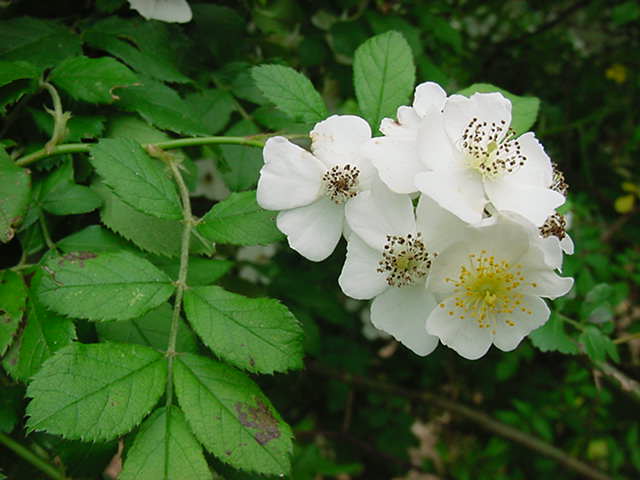
Multiflora rose was introduced to the eastern United States from Japan in 1886 as rootstock for cultivated roses. The species soon spread and became a serious invader of agricultural lands, pastures and natural communities throughout Illinois.
- Small plants can be dug out, but roots must be completely removed
- Mowing or cutting 3-6 times per growing season for at least 2-4 years
- Cut stump treatment with 20% glyphosate (ex. Round-up) within 5 minutes of cutting (30 minutes max)
- Basal bark treatment with 12.5% triclopyr (Crossbow, Garlon 4) formulated for use with penetrating oil
- Foliar treatment with 2% fosamine (Krenite S) in water applied between July and Sept will cause dieback the following summerBroadleaf-specific solution of metsulfuron-methyl (Escort) plus a surfactant applied as a foliar treatment
- Mowing or cutting followed by spot treatment of resprouts with triclopyr (Ex. Brush-B-Gon, Crossbow) formulated for water dilution
- Foliar treatment with 1% glyphosate (ex. Round-up) when plants are budding or flowering
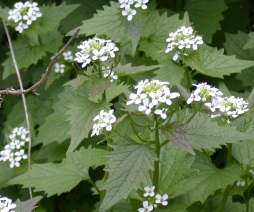
Garlic mustard is native to Europe. It was introduced to the United States in the late 1800s. Garlic mustard is capable of dominating the ground layer in many areas. It is a severe threat to many natural areas because of its ability to grow to the exclusion of other herbaceous species.
- Seeds remain viable for at least 7 years
- Itís better to weed at area thoroughly rather than try to cover too much territory
- Revisit weeded areas at regular intervals in the spring to find missed plants
- For large patches, work from the least-infested outer edges to the most-infested middle, concentrating on removing the second-year plants before they disperse their seed
- Plants can also be cut as close to the ground as possible (less than 2 inches) just after flower stalks have shot up, but before the flowers have opened. This method has mixed results.
- If flowering has begun (or finished), both pulled and cut plants should be bagged
-
Foliar treatment with a 1-2% glyphosate (ex.
Round-up) in early spring while native plants are still dormant
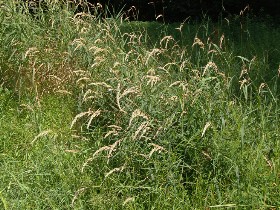
Reed canary grass is a coarse, sod-forming, cool-season, perennial grass, native to temperate regions of Europe, Asia, and N. America. It occurs from wet to dry habitats with best growth on fertile and moist or wet soils. Although reed canary grass has been valuable for forage, it has become a threat to some of our native wetland plant communities.
- Difficult to control because of the huge seedbank
- Small patches can be dug up or covered with black plastic for at least one growing season
- Close mowing 3 times per year - in spring, at flowering, and in late fall
- 5% glyphosate (ex. Round-up) applied to young shoots in early spring. Remove dead leaves from the previous year for better exposure.
- Mowing in mid-September followed by 5% glyphosate (ex. Round-up) in October may be more effective than spring treatment
White Mulberry
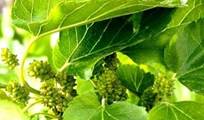
The white mulberry is native to eastern and central China. It became naturalized in Europe centuries ago. The tree was introduced into America for silkworm culture in early colonial times and naturalized and hybridized with the native red mulberry.
- Girdling
- Basal bark treatment with 12.5% triclopyr (Crossbow, Garlon 4) formulated for use with penetrating oil
- Imazapyr
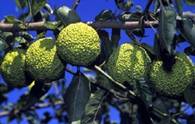
Osage orange is also known as hedge apple or bow wood. Osage orange is a native of Arkansas, Texas and Oklahoma that has been planted in Illinois and become naturalized here.
- Cut stump or Basal bark treatment with 12.5% triclopyr (Crossbow, Garlon 4) formulated for use with penetrating oil
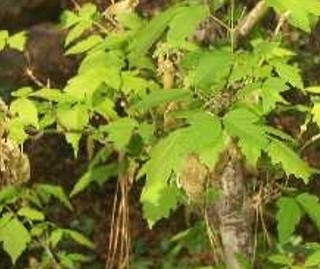
Box elder is an opportunistic species native to the United States. Extremely prolific, it will inhabit many environments disturbed by humans, including abandoned roads and railroad beds, deserted gravel pits, the peripheries of dumps, and areas around fences and buildings. It is common in rural yards, and its presence is often associated with past or present human occupation of an area.
- Cut stump or Basal bark treatment with 12.5% triclopyr (Crossbow, Garlon 4) formulated for use with penetrating oil
- Cut stump treatment with glyphosate (ex. Round-up) within 5 minutes of cutting (30 minutes max)
Raspberries/Blackberries
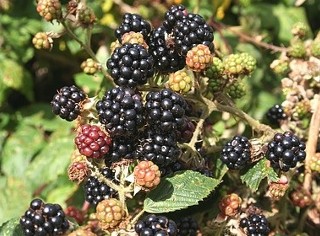
The blackberry plant is a very common shrub with thorny stems and pink or white flowers. It grows wild in hedgerows and woods. The berries are black, purple or deep red and rather delicate. The black, ripe berries have a wonderful flavour and a sweetish, slightly acid taste. Very rich in antioxidants.
- Mowing or cutting followed by spot treatment of resprouts with triclopyr, glyphosate, or metsufuron-methyl
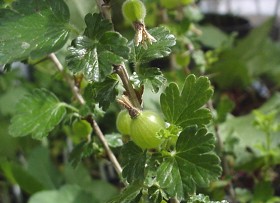
Gooseberries are deciduous shrubs, fast growing under optimum conditions to 3 feet tall and 6 feet wide. American types have weeping stems that will root wherever they touch the ground and can be invasive.
- Pull plants out when ground is moist
- Mow or cut twice a year for several years
- Cut stump treatment with 20-25% glyphosate (Roundup Pro) or 12.5% triclopyr (Crossbow, Garlon 4) in fall
- Foliar treatment with triclopyr after leaf-out in the spring
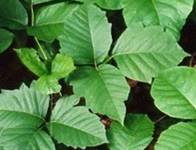
POISON IVY is a nuisance to people but compensates by having considerable wildlife value. The white, waxy berries are a popular food for songbirds during fall migration and in winter when other foods are scarce. Many birds feed on insects hiding in the tangled vines. Small mammals and deer browse on the poison ivy foliage, twigs and berries.
- Control is only necessary near trails and other areas used by humans
- Pull or dig in late fall for least exposure
- Foliar treatment of 1% triclopyr
- Foliar treatment of glyphosate (Ex. Round-up) or 2,4-D amine in late spring or early summer (not as effective as triclopyr)
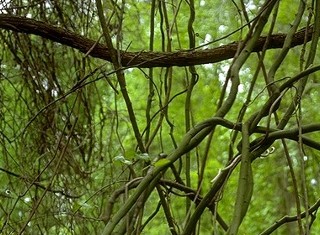
Wild grapes are often considered a nuisance weed, as they cover other plants and form thick entangling vines.
- Never just cut them off without applying herbicide - they will resprout like crazy
- Cut stem treatment with 20-25% glyphosate (Ex. Round-up)
- Basal bark treatment with 12.5% triclopyr (Crossbow, Garlon 4) formulated for use with penetrating oil
Wood Nettle
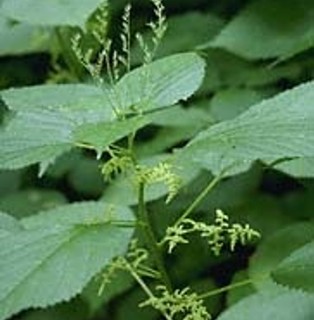
Wood nettle covers the floor of flood plain forests. It has stinging hairs on leaves that carry a toxic agent. The stinging hairs act like a hypodermic needle and consist of a fine capillary tube with a bladderlike base that is filled with the chemical irritant. At the tip of the hair is a minute cap that breaks off on contact with the skin. The sharply pointed tip then penetrates the skin and injects the toxic fluid. The result is an intense burning and itching of the skin that persists for minutes to a few hours
- Mowing or cutting
- Hand pulling
- If herbicide is necessary, 2,4-D amine is effective
|
Home Burning Bylaws Covenants History Maps Newsletters Phones Septic Recycling Water Aerial Animals Birds Bluebells Fungi Gardens Invasives Pets Streets Trail Trees Wildflowers |
This page was last updated Wednesday February 15, 2012.